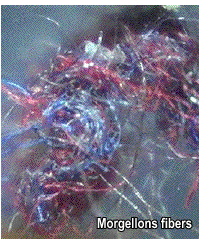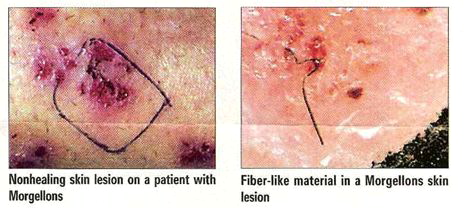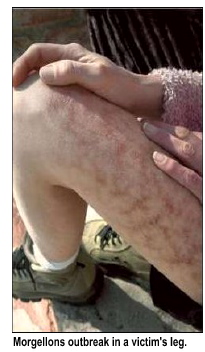
News
Behind the Headlines
Two-Cents Worth
Video of the Week
News Blurbs
Articles
Testimony
Bible Questions
Internet Articles (2015)
Internet Articles (2014)
Internet
Articles (2013)
Internet Articles (2012)
Internet Articles (2011)
Internet Articles (2010)
Internet Articles
(2009)
Internet Articles (2008)
Internet Articles (2007)
Internet Articles (2006)
Internet Articles (2005)
Internet Articles (2004)
Internet Articles (2003)
Internet Articles (2002)
Internet Articles (2001)


Morgellons Syndrome: Old Plague, New Disease.
 A
mysterious, rare parasitic disease called Morgellons Syndrome by
biologist Mary Leitao of McMurray, Pennsylvania who discovered—or
rather, rediscovered—it in 2002 because doctors could not identify
it, is taking its toll on an estimated 7,000 US citizens. Up until Leitao named it, the medical community had no answer to [a] what it was,
[b] what triggered the condition, and [c] how to kill the unidentified
parasite that indiscriminately attacks men, women and children.
A
mysterious, rare parasitic disease called Morgellons Syndrome by
biologist Mary Leitao of McMurray, Pennsylvania who discovered—or
rather, rediscovered—it in 2002 because doctors could not identify
it, is taking its toll on an estimated 7,000 US citizens. Up until Leitao named it, the medical community had no answer to [a] what it was,
[b] what triggered the condition, and [c] how to kill the unidentified
parasite that indiscriminately attacks men, women and children.
Morgellons
Syndrome, which many in the medical community still insist is an imaginary
disease caused by too much Internet exposure and too much time on someone's
hands, is not only real, but there is no consistent protocol to treat
it. Nor, does it appear, is there a consistent manner in which its victims
contract the disease. Morgellons presents itself with the sensation
of bugs crawling around just under your skin.  When
the disease, first described 350 years ago, reappeared in 2002, it was
dismissed by doctors as a psychiatric condition known as "delusional
paraitosis." The condition was first recorded by Sir Thomas
Browne in 1674. Browne described it as itching caused by some
type of wormlike parasite crawling around just under the skin. The sensation
was accompanied by biting, stinging and, occasionally, the brightly colored
parasite burrowing out of the skin for a few moments, then retreating
back into the epidermis.
When
the disease, first described 350 years ago, reappeared in 2002, it was
dismissed by doctors as a psychiatric condition known as "delusional
paraitosis." The condition was first recorded by Sir Thomas
Browne in 1674. Browne described it as itching caused by some
type of wormlike parasite crawling around just under the skin. The sensation
was accompanied by biting, stinging and, occasionally, the brightly colored
parasite burrowing out of the skin for a few moments, then retreating
back into the epidermis.
Chemtrailers
are convinced that Morgellons Syndrome is the result of government
experimentation, and that its victims contract it through chemtrail debris.
Interesting theory. Wrong conclusion. Morgellons Syndrome is a
parasitic infection.  The
parasite appears to be a filarial nematode that acts like a silkworm,
leaving behind a trail of bizarre fibers. If the condition was caused
by inhaling either an inorganic chemical or biological agents, or having
them land on the victim with the ability to penetrate the skin and burrow
into the epidermis, the chemical or biological agent would still be inorganic
on, or in, the human body. In addition, if that was the case, countless
hundreds of thousands, if not millions, of people would have been exposed
to the chemtrails. Why would only 7,000 or so people in the United States
contract the disease? The only answer: because its not related to chemtrails.
The
parasite appears to be a filarial nematode that acts like a silkworm,
leaving behind a trail of bizarre fibers. If the condition was caused
by inhaling either an inorganic chemical or biological agents, or having
them land on the victim with the ability to penetrate the skin and burrow
into the epidermis, the chemical or biological agent would still be inorganic
on, or in, the human body. In addition, if that was the case, countless
hundreds of thousands, if not millions, of people would have been exposed
to the chemtrails. Why would only 7,000 or so people in the United States
contract the disease? The only answer: because its not related to chemtrails.
Of course, as advocates of the chemtrail theory insist, it may be that the disease simply has not manifested in its other victims yet, or they may be being treated by their dermatologists for eczema, cellulitis, scabies, or some other skin disorder as they complain that there are bugs crawling around under their skin.
Modern Morgellons has been around longer than chemtrails. Dr. C.E. Kellot first identified it in 1935. He used the provincial term, masclous (little flies) to describe it. Dr. Jeffrey Meffert, MD, Associate Professor of Dermatology at the University of Texas has attempted to debunk Morgellons Syndrome as a nonexistent disease. He agrees that patients have something, but it's more likely scabies or some form of eczema which he believes may be prurigo modularis (a skin disorder characterized by itchy pea-sized nodules which usually appear on the arms and/or legs). However, prurigo nodularis may look like a Morgellons outbreak in its initial stage, but as the disease progresses, prurigo nodularis does not develop the fiber strands which are prevalent in all patients exhibiting symptoms of Morgellons Syndrome.
 It
was summer, 2001. It was late evening in a middle class home on a wooded,
dead-end street in the McMurray area of Peters, Pennsylvania. Mary
Leitao's husband was sleeping. He came home from work, tired. Hard
day. Leitao's two oldest children, Samantha and Jeremy had also gone to bed. Leitao's 2-year old son, Drew, was
sick. He had a irritated spot under his bottom lip—which he told
his mother felt like it was "full of bugs."
It
was summer, 2001. It was late evening in a middle class home on a wooded,
dead-end street in the McMurray area of Peters, Pennsylvania. Mary
Leitao's husband was sleeping. He came home from work, tired. Hard
day. Leitao's two oldest children, Samantha and Jeremy had also gone to bed. Leitao's 2-year old son, Drew, was
sick. He had a irritated spot under his bottom lip—which he told
his mother felt like it was "full of bugs."
Leitao had taken Drew to several Pittsburgh-area dermatologists and pediatricians. None could identify what Drew had. Most referred to it as a case of scabies or eczema. They prescribed various ointments and creams to treat it. None of them worked. On this night, she bathed Drew and was applying a cream ointment that appeared to be working well to stop the itch. Drew lay in his mother's lap, lulled by the bath and his mother's caress. Leitao began rubbing the ointment on her son in gentle, circular motions. Something unusual happened. A fiber-like substance came from Drew's skin. She collected a sample of the fibers and got her older son's $8 Radio Shack microscope and looked at the fibers. Since that night, she has examined those strands—and others—under various microscopes at the University of Massachusetts and, later, as a medical researcher at a Boston-area hospital.
The fibers now obsessed her completely because of what she sees in people with Morgellons Syndrome—a name she coined based on her study of the research done by Sir Thomas Browne—are at odds with the majority of the American medical community which still believes Morgellons does not exist.
But if you
ask former Oakland Athletics relief pitcher Billy Koch or
his wife Brandi, or California resident Verna Gallagher,
each of them will assure you, it's real. When Morgellons struck Koch, he was sold by the Toronto Blue Jays to Oakland,
and from Oakland to Chicago and, finally, from Chicago back to Toronto. He developed a mysterious illness in 2004. So
did his wife Brandi. What was the mysterious illness? According
to Brandi Koch, it consisted of strings and black specks coming
out of their skin.  "[Billy]
freaked out," she said. "He wanted to ignore it. I wanted
to, too. But when it comes to your kids, you gotta stop ignoring it." In two years Koch was out of pro ball. The fans couldn't understand
the illness because his body didn't twitch and he showed no signs that
he was sick when he pitched. Except, he stopped winning games. And the
teams that owned his contract dumped him.
"[Billy]
freaked out," she said. "He wanted to ignore it. I wanted
to, too. But when it comes to your kids, you gotta stop ignoring it." In two years Koch was out of pro ball. The fans couldn't understand
the illness because his body didn't twitch and he showed no signs that
he was sick when he pitched. Except, he stopped winning games. And the
teams that owned his contract dumped him.
When it first struck Brandi Koch, she said she began to be increasingly forgetful and detached. Her doctor diagnosed her as having Lyme Disease. "Then," she said, "the horror really started. I noticed there was some kind of matter coming out of my skin, not just where I had sores." Prior to the illness, she worked regularly and competed in 10K runs. Then her legs and arms began to swell, and for no reason, she got lesions on her back. Doctors decided she had an auto-immune disease, perhaps arthritis. Then they decided it was scleroderma. In truth, the doctors had no idea what was wrong and chose to ignore the fibers which she insisted were coming out of her skin. Attributing the fibers to the clothes she wore, they refused to associate them with her illness.
 Verna
Gallagher, 50, of Roseville, California has suffered from Morgellons for three years. Her dermatalogist doesn't believe in Morgellons and
is convinced the fibers she thinks are coming out of her skin is actually
clothing fiber and lint. The doctor is concerned that she might be suicidal
because she now cries a lot. Meanwhile, Gallagher says she is concerned
about the dark specks and fibers that now infest her house. She has paid
for exterminators, bathed in Borax, takes antidepressants and spends hundreds
of dollars on vitamins, garlic pills and other potential remedies she's
found on the Internet. Now Gallagher has become a hermit in her
own home, spending most of her day isolated in her bedroom to reduce the
chances of infecting others.
Verna
Gallagher, 50, of Roseville, California has suffered from Morgellons for three years. Her dermatalogist doesn't believe in Morgellons and
is convinced the fibers she thinks are coming out of her skin is actually
clothing fiber and lint. The doctor is concerned that she might be suicidal
because she now cries a lot. Meanwhile, Gallagher says she is concerned
about the dark specks and fibers that now infest her house. She has paid
for exterminators, bathed in Borax, takes antidepressants and spends hundreds
of dollars on vitamins, garlic pills and other potential remedies she's
found on the Internet. Now Gallagher has become a hermit in her
own home, spending most of her day isolated in her bedroom to reduce the
chances of infecting others.
In 2006, a young man in Texas who was afflicted with Morgellons Syndrome committed suicide because his doctors refused to believe there were "things" growing out of his skin. "Parasitosis is a classic form of shared delusion," Dr. Mary Seeman of the University of Toronto said. "Skin disease is [a] perfect [catalyst] for it. A person gets in a rush or something, then the disease spreads through any shared space in which there is close contact." One woman, she said, convinced her husband that neighbors were shooting at her with lasers. Another convinced her sister that they were both being attacked by bugs. "When a person has something bothering him these days," Seeman said, "they get online [where they] get reinforcement [of their] ideas." And, of course, the conspiracy is born.
Mary Leitao, who in Seeman's view would likely be one of the ringleaders of the fiber conspiracy, created the Morgellons Research Foundation website in her home using her own limited financial resources. But Drew Leitao, like most of those who have been—and still are—misdiagnosed, still see doctors who fail to believe that the fibers are not related to the illness, which is still being diagnosed as eczema.
 When Sue Laws of Gaithersburg, Maryland first experienced Morgellons
Syndrome, it felt like bees stinging her back. The stinging sensation
was so severe she screamed for her husband. When he checked her back,
there appeared to be nothing there. She didn't believe him. To prove it,
he stuck duct tape on her back and ripped it off to prove it was nothing.
The tape was covered with tiny red fibers. Only, Laws was not wearing
any red clothing. Over the next few months, the itching got worse. And,
worse yet, it felt like there were bugs crawling around under her skin.
Her doctor, of course, could find nothing wrong.
When Sue Laws of Gaithersburg, Maryland first experienced Morgellons
Syndrome, it felt like bees stinging her back. The stinging sensation
was so severe she screamed for her husband. When he checked her back,
there appeared to be nothing there. She didn't believe him. To prove it,
he stuck duct tape on her back and ripped it off to prove it was nothing.
The tape was covered with tiny red fibers. Only, Laws was not wearing
any red clothing. Over the next few months, the itching got worse. And,
worse yet, it felt like there were bugs crawling around under her skin.
Her doctor, of course, could find nothing wrong.
Believing she was suffering from insect infestation, the Laws tore up all of the carpeting in their home and sanded the floors. Then, suspecting it might be some type of mold, they stripped off all the wallpaper and painted the walls. Her condition worsened.
 Every
morning she found black specs on her sheets, and where the specks were
on her body, there were droplets of blood. Like the Kochs', her joints
began to ache. But, in her case, her hair began to fall out and, for no
reason, her teeth began to rot. Then one morning as she looked in the
mirror, a pink worm came out of one of her eyeballs. Sue Laws was
convinced she was going to die a very horrible death. It was at that time
she found Mary Leitao's website. What the Laws were experiencing
was the laundry list of symptoms for Morgellons—except the
pink worm. No other Morgellons victim has reported that oddity
of the disease.
Every
morning she found black specs on her sheets, and where the specks were
on her body, there were droplets of blood. Like the Kochs', her joints
began to ache. But, in her case, her hair began to fall out and, for no
reason, her teeth began to rot. Then one morning as she looked in the
mirror, a pink worm came out of one of her eyeballs. Sue Laws was
convinced she was going to die a very horrible death. It was at that time
she found Mary Leitao's website. What the Laws were experiencing
was the laundry list of symptoms for Morgellons—except the
pink worm. No other Morgellons victim has reported that oddity
of the disease.
Christina (last name omitted by victim), a New Yorker, decided to "winter" in a rented condo in Florida in 2004. Within a month or so, she began to wonder if the rented house was infested with fleas. She was experiencing what felt like bug bites; and she developed a nagging itch. One Florida friend thought she might have noseeums (a microscopic mite), or possibly chiggers, or some other form of mite, and gave her remedies for all of them. Because the people who owned the house had a dog and because several stray cats constantly hung around the home, Christina set off a bug bomb to kill what she believed was a flea population—eight times.
When she returned to New York in the spring, she passed the infection on to her sister, two daughters and a granddaughter. Like Mary Leitao's son Drew, the Koches, Gallagher and Sue Laws, Christina experienced all of the Morgellons symptoms. Her doctor, like everyone else's doctor, gave her lotion for the itching and the constant stinging sensation. While her sister and daughter—both blood relatives—contracted the disease from, her daughter's husband and grandson did not. After a year-and-a-half of suffering, Christina discovered Mary Leitao's Morgellons Research Foundation website and realized what it was that she had. But, like every other victim of Morgellons, she still has the problem because the medical community insists on calling it eczema. And no one has yet discovered how to cure Morgellons.
Carol Doe, also a New Yorker and also an alias, managed the employee communications department for a Fortune 100 company until she contracted Morgellons Syndrome. Where she used to spend hours each week negotiating multi-million dollar contracts for her company, she now has trouble writing simple statements—which can take a whole day, or longer, to construct. She also has trouble getting out of bed before noon. She no longer drives, and no longer invites friends into her home. And, she no longer allows her husband to share their bed, fearful that she will pass her horrible disease on to him. In 2006 her doctor correctly diagnosed her as having Morgellons Disease.
Pam Winkler of Bel Air, Maryland was a placid suburban housewife. She had two beautiful children and a bright future until she contracted this strange malady that some people were calling the "fiber disease." When Morgellons struck, the doctors told her it was her imagination. And, because everyone insisted it was "in her mind," Winkler began to believe that perhaps it was. She ended up in a psychiatric ward of a suburban DC hospital against her will, and ended up on antipsychotic medication—also against her will. In the end, using her confinement as grounds, her husband divorced her and gained custody of their children. According to Winkler, she still blows black fibers and specks from her nose. The doctors who were treating her at the mental facility insist the lesions and black fibers are self-inflicted.
While the medical community is still skeptical that Morgellons is a real medical condition, thousands of those afflicted with the disease have flooded Congress with letters, demanding that they devote the research dollars needed to identify the origin of the disease and find an adequate treatment, and cure, for it. As a result of pressure from the public, the Centers for Disease Control [CDC] agreed, on Jan. 17, 2008, to dedicate a million dollars a year in 2008 and 2009 for an epiderminological study on what the CDC termed "an unexplained dermopathy" which was now affecting approximately 2,000 new victims each year. Leitao claims 7,000 people have registered with the Morgellons Research Foundation, the CDC has thus far found over 11,000 families in the United States that are affected with the strange, as yet medically undefined disease.

Copyright © 2009 Jon Christian Ryter.
All rights reserved.


